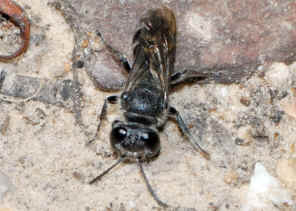Subfamily Crabroninae - Sand-loving Wasps and Sand-dauber Wasps
Family Crabronidae
- This page contains pictures and information about Sand-loving Wasps subfamily Crabroninae that we found in the Brisbane area, Queensland, Australia. Some reference named this subfamily as Larrinae.

- Wasps in this subfamily Crabroninae are medium to large in size, with long body and usually black (and orange), more elongate than Bembicinae. They have spiny-legged and frequently with deformed ocelli. They generally provision with Orthoptera. Some species provision with spiders.
Larrini - Sand-loving Wasps
- Wasps in tribe Larrini are medium size. They have the hind ocelli modified, sometimes with near-complete loss of the lens. Orbits straight. Australian species prey on Orthoptera. The Australian species include Larra, Liris, Tachytes and Tachysphex.
- Black Sand-loving Wasp


- Tachysphex sp., body length 15mm
- The Black Sand-loving Wasp is entirely shiny black in colour. We recognized the wasp in this tribe by the wing vein pattern. More information can be found in this page.
- Grey Sand-loving Wasp


- ? Larra sp., body length 15mm
- Pictures were taken in a bush near Mt Cotton during mid winter. The wasp was searching among the plant materials on the ground. Please check this page for more information.
Miscophini
Wasps in tribe Miscophini have the Orbits straight and hind ocelli normal. They prey on different insects and spiders. The Australian species include Sericophorus, Sphodrotes, Auchenophorus, Lyroda and Nitelaand.
Trypoxylonini - Sand-dauber Wasps
- Wasps in tribe Trypoxylonini have the emarginated eyes. They prey on spiders. They are usually black and some with orange-yellow colours. The Australian species include Trypoxylon and Pison.
- Brown Sand-dauber Wasp



- Pison sp., nest size 30x40mm, wasp body length 12mm
- We found this small mud nest under a shrub in late summer 2006. There was one small hole on the nest. We brought it home to see what would come out. Few days later we found four small brown wasps came out. We have more records on this page.
- Black Sand-dauber Wasp I


- Pison sp., body length 10mm
- We saw this wasp collecting mud on footpath in Carbrook Wetland on Sep 2009. Please check this page for more information.
- Black Sand-dauber Wasp II


- Pison sp., body length 15mm
- The wasps spend most of their time on collecting mud and build the hanging nest. From reference information, the wasp prey on spiders. We had opened one empty cell and found some spider body remains. Please check this page for more information.
- Mud Nest Tenant Wasp



- ? Pison sp., body length 15mm
- Dec 2008 in Karawatha Forest, we saw this wasp, it seems collecting mud for mud-cells. We believed this wasp re-use the empty mud cells of the Mud-Dauber Wasp as its own nest for the young. Details please check this page.
- Wasps in Crabronini which does not have the sub-marginal and discoidal cells fused. In Australia this is a small tribe.
- Reference:
- 1. Insects of Australia, CSIRO, Division of Entomology, Melbourne University Press, 2nd Edition 1991, pp 991.
- 2. Insects of Australia and New Zealand - R. J. Tillyard, Angus & Robertson, Ltd, Sydney, 1926, p299.
- 3. Northern Territory Insects, A Comprehensive Guide CD - Graham Brown, 2009.
- 4. Sphecidae - Insects of Townsville, Australia - Graeme Cocks.
